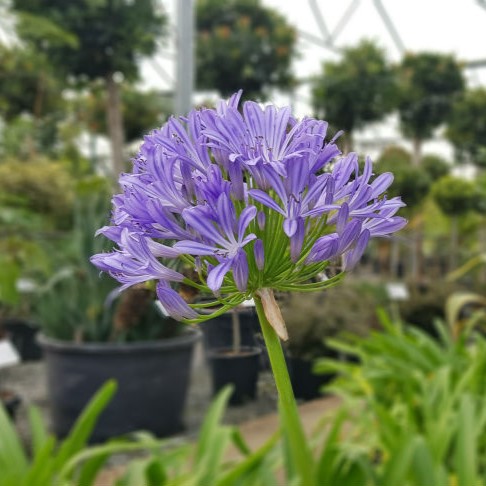Agapanthus Buddy Plant Kingdoms: Perfect Pairings for Your Yard
Agapanthus Buddy Plant Kingdoms: Perfect Pairings for Your Yard
Blog Article
Letting Loose the Secret to Effective Agapanthus Farming: Idea for a Flourishing Yard
In the world of gardening, cultivating agapanthus effectively calls for a calculated strategy that includes numerous aspects of plant treatment. By recognizing the subtleties of agapanthus growing, one can create an atmosphere where these plants flourish and grow generously.
Growing Agapanthus: Best Practices
When planting Agapanthus, proper soil prep work is essential for making certain successful growth and growth of these attractive blossoms. Agapanthus, generally recognized as Lily of the Nile or African lily, prospers in well-draining soil with a slightly acidic to neutral pH level - Agapanthus. Before growing, it is important to amend hefty clay dirts with raw material such as garden compost or peat moss to boost drainage and supply important nutrients for the plants
To grow Agapanthus, choose a place that gets complete sunshine to partial color, as this will certainly advertise healthy and balanced development and bountiful flowering. Dig an opening two times the size of the plant's root ball and put the Agapanthus at the same depth it was formerly growing. Gently backfill the opening with soil, pressing down strongly to get rid of any kind of air pockets around the roots.
Water the recently grown Agapanthus extensively and remain to keep the soil evenly moist, particularly throughout the plant's energetic expanding period. Agapanthus. Applying a well balanced plant food once a month can additionally support the plant's growth and blooming. By adhering to these finest techniques for planting Agapanthus, you can produce a sensational display of these fascinating blossoms in your garden
Suitable Dirt Conditions for Agapanthus
For optimal growth and flowering success of Agapanthus plants, ensuring the dirt conditions are excellent is vital. Agapanthus chooses soil that is abundant in nutrients, so including a well balanced plant food throughout the expanding season can promote healthy and balanced development and vibrant flowers.
:strip_icc()/agapanthus-africanus-b959396b-5696f86e059c46f299d1834ba687c6eb.jpg)
Watering and Fertilizing Tips
To make sure healthy and balanced development and dynamic flowers, proper watering and feeding methods are important for successful Agapanthus cultivation. Agapanthus plants profit from routine watering, specifically during the expanding season.
When it concerns fertilizing Agapanthus, a well balanced plant food with equal parts nitrogen, phosphorus, and potassium can be applied in the springtime to advertise healthy and balanced growth and flowering. Slow-release fertilizers are ideal for providing nutrients gradually over a prolonged period. Avoid over-fertilizing, as this can lead to too much foliage development at the cost of blossoms.
In addition, including organic issue like compost right into the dirt can enhance nutrient degrees and enhance soil framework, aiding in the total health of the Agapanthus plants. By adhering try this to these watering and feeding ideas, garden enthusiasts can ensure their Agapanthus plants flourish and create magnificent display screens of flowers.
Trimming and Deadheading Techniques
Proper trimming and deadheading methods play an important role in keeping the health and wellness and appearances of Agapanthus plants, matching the necessary techniques of watering and fertilizing for successful farming. Pruning Agapanthus includes getting rid of spent flower heads, dead or yellowing leaves, and general shaping of the plant to advertise better development. Deadheading, the procedure of eliminating discolored flowers, not just enhances the plant's visite site appearance yet likewise urges further growing.
When deadheading Agapanthus, it is recommended to trim off the blossom stem at the base making use of sharp, tidy shears. This procedure redirects the plant's energy from seed manufacturing back into origin and foliage growth, promoting a healthier and extra durable plant. Routine deadheading can expand the blooming period check out here of Agapanthus and prevent self-seeding, which can lead to overcrowding.
In regards to trimming, Agapanthus typically gain from a light trim after blooming to clean up the plant and encourage fresh growth. Cutting down the invested blossom stems and removing any kind of dead or damaged vegetation assists keep the plant's vigor and general appearance. However, it is important to avoid cutting into the crown of the plant, as this can compromise its health.

Protecting Agapanthus From Pests and Diseases
Carrying out efficient parasite and condition monitoring approaches is essential to securing the health and vitality of Agapanthus plants in cultivation. One usual insect that impacts Agapanthus is the Agapanthus borer, a caterpillar that tunnels into the plant, causing damage to the leaves and blossoms.
In addition to bugs, Agapanthus are at risk to illness such as root rot and fungal leaf places. By remaining vigilant and attending to bug and disease concerns immediately, gardeners can aid their Agapanthus thrive and grow.

Conclusion
In final thought, successful cultivation of agapanthus requires proper growing techniques, suitable soil problems, ample watering and feeding, routine trimming and deadheading, and defense from diseases and insects. By adhering to these methods and pointers, gardeners can guarantee a prospering yard full of beautiful agapanthus blossoms. Agapanthus. Remember to keep regular care and attention to information to promote the health and durability of these magnificent plants
When growing Agapanthus, proper soil prep work is vital for ensuring effective growth and development of these gorgeous blossoms.Water the recently planted Agapanthus extensively and proceed to maintain the soil equally wet, particularly throughout the plant's energetic expanding period.For optimal development and flowering success of Agapanthus plants, making sure the soil problems are optimal is essential. When growing or transplanting Agapanthus, make certain the dirt is well-prepared to supply the needed structure for the plants to develop themselves effectively. One common bug that influences Agapanthus is the Agapanthus borer, a caterpillar that tunnels right into the plant, creating damage to the leaves and flowers.
Report this page